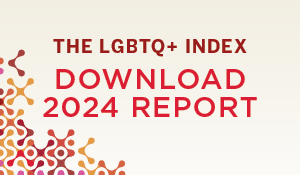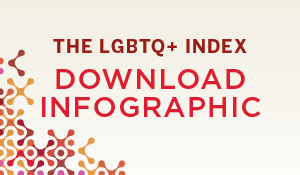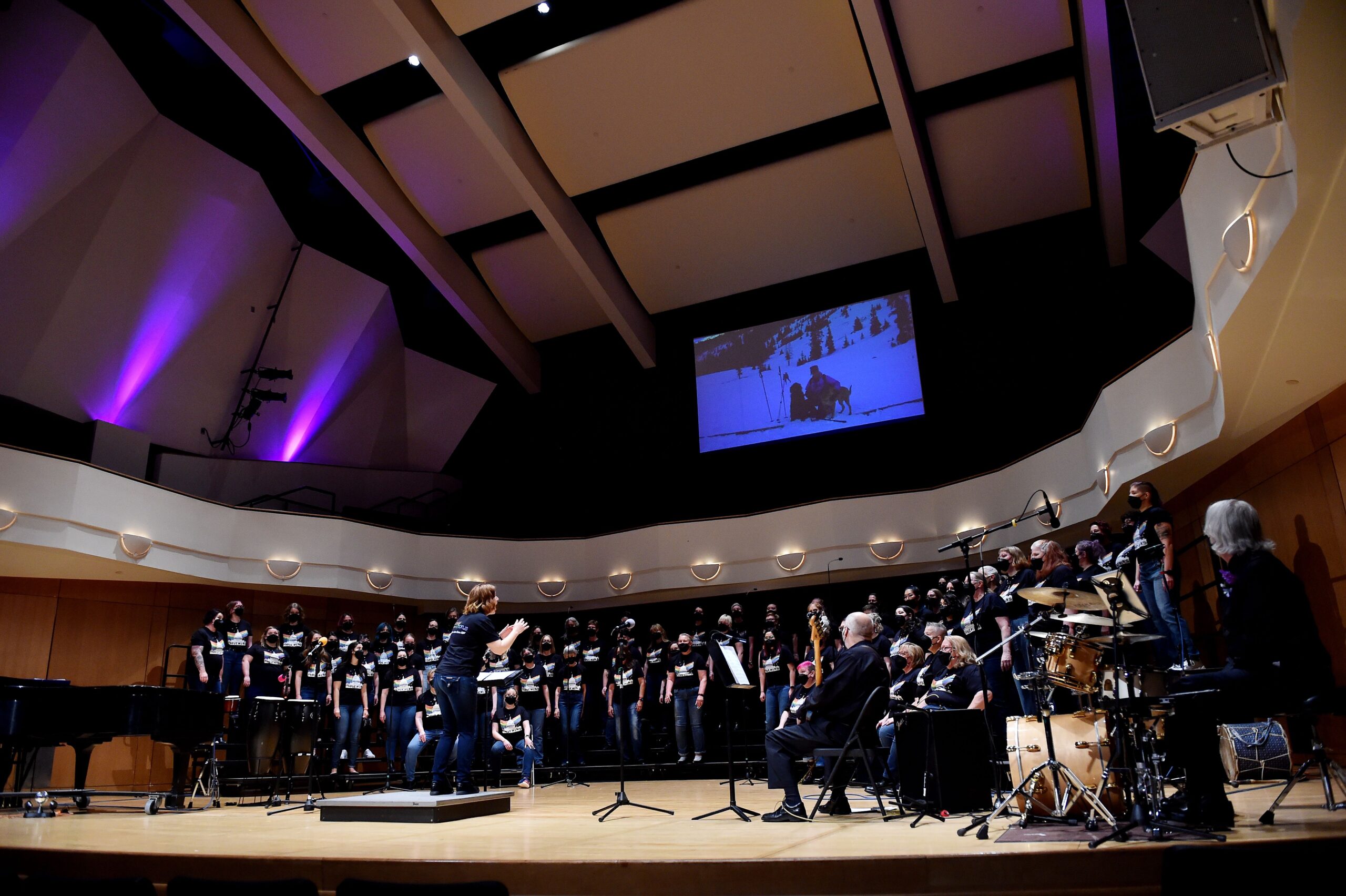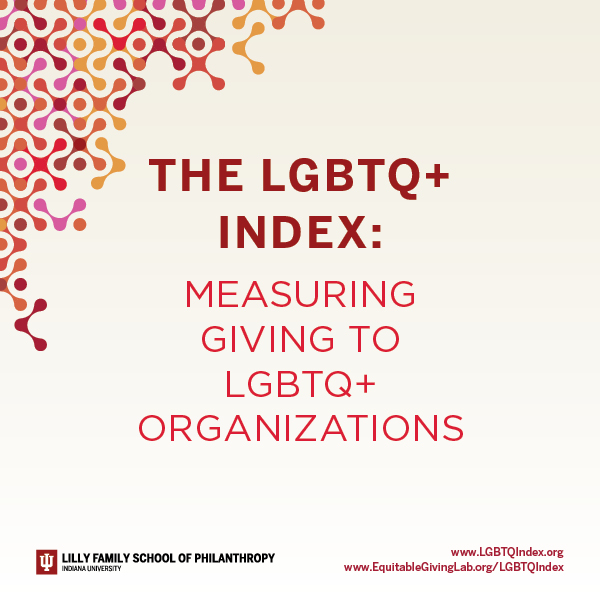The LGBTQ+ Index
Launched in May 2023, the LGBTQ+ Index is a groundbreaking tool that measures charitable giving to U.S. organizations serving the LGBTQ+ community.
Announcing the latest LGBTQ+ Index: Measuring Giving To LGBTQ+ Organizations
The LGBTQ+ Index 2024 is the only comprehensive index of charitable organizations in the U.S. that serve LGBTQ+ causes and communities. The second annual LGBTQ+ Index shows a decade of growth amid ongoing challenges for these organizations, yet LGBTQ+ organizations receive less than $1 dollar out of every $500 donated.

Search for LGBTQ+ organizations
You can search the LGBTQ+ Index for organizations based on criteria like keyword, focus area, and geographic location.
LGBTQ+ Index Resources

LGBTQ+ Index 2024
Research Report

LGBTQ+ Index 2024
Infographic

LGBTQ+ Index 2024
Dataset
LGBTQ+ Organization Case Studies

National Center for Lesbian Rights
Case Study

Rocky Mountain Arts Association
Case Study

Transgender Resource Center of New Mexico
Case Study

Trinity Haven
Case Study
LGBTQ+ Index Virtual Event
Held on June 7, 2023, this event included a brief presentation of the findings from the Index, followed by a panel discussion with funders and leaders of LGBTQ+ organizations.

LGBTQ+ Index FAQs
Who developed the LGBTQ+ Index? How is it funded?
The LGBTQ+ Index was developed by the the Indiana University Lilly Family School of Philanthropy at IUPUI. The school is dedicated to improving philanthropy to improve the world by training and empowering students and professionals to be innovators and leaders who create lasting and positive change.
The LGBTQ+ Index was developed with funding from Google.org, as part of the Equitable Giving Lab.
What data are used to compile the LGBTQ+ Index?
The LGBTQ+ Index includes 501(c)(3) public charities primarily dedicated to serving the LGBTQ+ community that were active from 2012 to 2021—the most recent year for which more than 99% of finalized IRS data on charitable organizations were available as of December 2023. The analyses in this report focus on this ten-year period from 2012 to 2021, while also highlighting changes from 2019 to 2021, the most recently added data. Analyses in this report illustrate key characteristics of LGBTQ+ organizations, including the amount of total philanthropic support they receive from individuals, foundations, and corporations. To offer context, the findings compare LGBTQ+ organizations with non-LGBTQ+ organizations and with the traditional nonprofit subsectors as defined by Giving USA.
Several data sources form the basis for the LGBTQ+ Index, the most important of which are e-file Internal Revenue Service (IRS) data available on Amazon Web Services and irs.gov that provide details for 410,716 501(c)(3) public charities filing IRS Forms 990 and 990-EZ electronically for circa fiscal year 2021. These data were supplemented with 900 digitized Form 990 paper returns provided by Candid (formerly GuideStar) and 19,636 Form 990 and 990-EZ returns from IRS Return Transaction Files (RTF). For organizations not filing an IRS Form 990 or Form 990-EZ, a combination of 619,921 charitable organizations filing Form 990-N and 454,527 “non-filing” registered charitable organizations were used to gather information on typically smaller and religious organizations, for a total population of 1,505,790 registered 501(c)(3) domestic charitable organizations for fiscal year 2021. Non-filing organizations are defined as registered tax-exempt organizations that did not file any type of Form 990 between the fiscal years ending in 2021, most of which are religion-related charitable organizations exempt from annual 990 filing requirements. The final set of LGBTQ+ Index inclusion and exclusion rules was applied to the full population of 2,250,753 registered charitable organizations found in IRS Business Master Files (BMF) between 1989 and 2024.
What years of data are included in the LGBTQ+ Index? Why does the data stop at 2021?
The LGBTQ+ Index includes data from ten years—2012 to 2021. Analyses in the 2024 LGBTQ+ Index report are based on this decade-long period, and also zoom in on the most recently-obtained data for 2020 and 2021.
When data collection for the LGBTQ+ Index began in December 2023, 2021 was the most recent year for which more than 99% of finalized IRS data on charitable organizations was available.
How are LGBTQ+ organizations defined?
To be included in the LGBTQ+ Index, nonprofits must be primarily dedicated to serving the LGBTQ+ community (with approximately 80% or more of program expenses serving this purpose for organizations that do not exclusively focus on the LGBTQ+ community).
This definition may seem straightforward, but measuring giving to the LGBTQ+ community is quite challenging since many charitable organizations have multiple programs that serve different populations. As such, the researchers exercised a certain degree of judgment in creating the LGBTQ+ Index. For example, to the extent possible, the researchers tried to target HIV/AIDS organizations that specifically serve the LGBTQ+ community for inclusion in the Index. However, available information on these organizations often made it challenging to make this distinction.
How were LGBTQ+ organizations identified for inclusion in the Index?
Informed by a review of the relevant literature and published organization listings, the researchers developed initial sets of inclusionary words and phrases (key words), exclusionary words and phrases (stop words), and other criteria to establish logical “rules” to identify potential organizations for the LGBTQ+ Index. Generating the final set of nearly 50 rules (from nearly 100 tested) was an iterative process. Initial rules were applied to organization names, mission statements, and other identifiers. Manual verification of a random sample of the results led to modification of the initial rules and the creation of new rules.
Following this process, the final set of rules was applied to the full population of 2,250,753 registered charitable organizations found in IRS Business Master Files (BMF) between 1989 and 2023, resulting in 4,237 LGBTQ+ organizations, 3,091 of which were registered during circa 2021 per BMF. In total, the researchers hand-checked 5,527 of the 8,758 potential LGBTQ+ organizations identified based on available information.
The final set of LGBTQ+ Index rules and their sequencing are available upon request. The rules generally fall into the following 17 categories (exclusionary rules not shown):
- Arts and culture
- Civil rights and advocacy
- Community centers
- Education
- Elders and aging
- Environment and animals
- Health
- HIV/AIDS
- Homelessness
- Human Services
- Immigrants and refugees
- International
- Public-society benefit
- Religion
- Sports and recreation
- Transgender
- Youth
To measure philanthropic support for LGBTQ+ organizations, the direct support value was used for charitable organizations filing IRS Forms 990 (Part VIII, Lines 1b, 1c and 1f). Total contributions, gifts, and grants were used for organizations filing Form 990-EZ (Part I, Line 1). A direct contribution per organization estimate was used for those filing Forms 990-N (based on the average direct support value among Form 990 and Form 990-EZ filing organizations with less than $50,000 in revenue for the same filing year). No direct support estimate was used for non-filers.
What limitations does the LGBTQ+ Index have?
Despite extensive effort, there are certain caveats to this research due to the subjective nature of identifying and classifying organizations dedicated to the LGBTQ+ community, as well as data and resource limitations. Organizations were primarily hand-checked for inclusion in the Index; manual verification for alignment with the specific rule categories was limited. The researchers expect error rates to be minimal, but this could potentially affect the accuracy of dollar estimates for the rule categories.
The datasets used to generate the LGBTQ+ Index focus on public charities; they do not include financial data on religious congregations or any data on private foundations. The Index tracks total philanthropic support for LGBTQ+ organizations; the data cannot be disaggregated by funding source (e.g., individuals, foundations, corporations). While some religious organizations are included in the LGBTQ+ Index, many do not have any available government data and therefore could not be checked for inclusion.
Although the researchers recognize the importance of intersectional identities, the data on LGBTQ+ organizations cannot be disaggregated based on more specific demographics (e.g., LGBTQ+ women and girls, LGBTQ+ individuals of color, LGBTQ+ veterans) at this time. However, work is currently underway to achieve this through the creation of additional indices as part of the Equitable Giving Lab.
Why isn’t a specific organization in the LGBTQ+ Index?
Organizations may not appear in the WGI for a number of reasons. The most common reasons include:
- They do not primarily focus on LGBTQ+ issues or communities (approximately 80% or more of program expenses).
- They were incorporated after 2021.
- They are part of a larger organization that does not primarily focus on the LGBTQ+ community (for example, funds or foundations dedicated to LGBTQ+ issues but housed within larger community foundations).
- They are not 501(c)(3) public charities (for example, 501(c)(4) nonprofits or private foundations).
- They are not incorporated as nonprofits (for example, informal organizations or private companies).
- They are not based in the United States.
If the above reasons do not apply to your organization and you believe it should be included in the LGBTQ+ Index, please contact jjbergdo@iu.edu.
How should the LGBTQ+ Index be cited?
The Lilly Family School of Philanthropy asks that the following citation accompany any use of the LGBTQ+ Index data or research: Indiana University Lilly Family School of Philanthropy and DataLake Nonprofit Research. (2024). LGBTQ+ Index [Data file].

